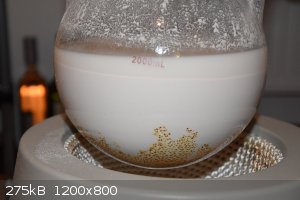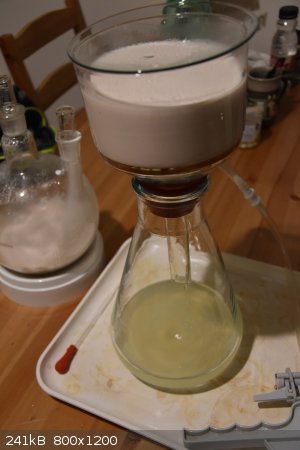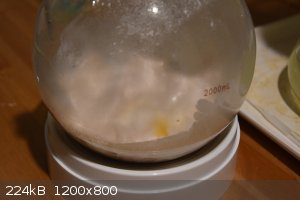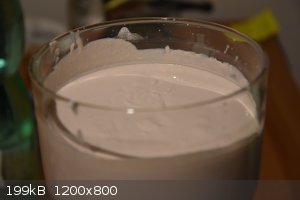| Pages:
1
2 |
nimgoldman
Hazard to Others
  
Posts: 303
Registered: 11-6-2018
Member Is Offline
|
|
Attempting anhydrous ethanol with CaO
I am trying to produce about a liter of anhydrous ethanol. I tried different methods but all have failed (molecular sieves lead to huge losses as they
get covered with EtOH; drying agents such as MgSO4 or CaSO4 don't work at all; magnesium cannot be used on azeotropic alcohol as there is too much
water).
The forum posts I read give mixed opinions to every method so I reverted to the old and proven method - refluxing with calcium oxide.
One writeup says to add 200 g of CaO per liter of alcohol. I had 1 400 ml so I added 240 grams of CaO.
Unfortunately, this amount makes magnetic stirring impossible even with a large and powerful stirrer.
Overhead stirrer cannot be used in a reflux setup (lack of insulation) so I hoped the CaO will smooth out boiling. No bumping happened and I continued
refluxing for about 8 hours (the writeup I read advised to reflux 24 hours but I already used 12 blocks of ice and not having more).
Unfortunately, there is some brown burnt stuff because of lack of stirring - see image.
I proceeded to vacuum filtration but it's also a real pain. It slowed down and the stuff is in no way dry - it's a wet pudding, refusing to filter.
The air always finds its way in, breaking the vacuum so I have to mix it with spatula from time to time, only to get few more drops. The process is
tedious.
I am afraid I will lose over 50% of ethanol using this method, not to mention the calcium oxide, which is hard and expensive for me to obtain, even
more than molecular sieves.
I wonder how this CaO method should be done correctly since it seems impossible to reflux such amount of CaO in alcohol without problems and it's not
possible to filter it without losing huge amounts of ethanol.
I feel lost as I already spent three months and liters of carefully distilled ethanol in my pursuit of anhydrous ethanol for syntheses. I don't want
to buy it since I want to find a way to make it myself (it is regulated and taxed - purchasing it as an individual is shady).
Maybe the only efficient way would be to use smaller amount of CaO, say, 100 grams per liter of alcohol, so it can be stirred. It won't produce
anhydrous ethanol, but the last two or so percent water could be removed using molecular sieves. This might get the better from both worlds.
Any tips for making anhydrous ethanol without losing huge amounts of it?
   
[Edited on 16-8-2018 by nimgoldman]
|
|
|
happyfooddance
National Hazard
   
Posts: 530
Registered: 9-11-2017
Location: Los Angeles, Ca.
Member Is Offline
Mood: No Mood
|
|
Have you tried potassium carbonate?
|
|
|
WGTR
National Hazard
   
Posts: 971
Registered: 29-9-2013
Location: Online
Member Is Offline
Mood: Outline
|
|
The first thing that jumps out at me is that you can try a filtering aid, like diatomaceous earth, on the Buchner funnel. It might help keep your lime
from clogging the filter paper, at least for a while.
Another out-of-the-box wild idea is to try filling a wide-mouthed container with your alcohol, and then float a smaller container in the middle that
contains your CaO. Then seal the lid, of course. Assuming that the water and alcohol will have their own respective vapor pressures, it may take
quite a while for all of the water to leave the alcohol and react with the CaO. Maybe you could put a stir bar in the container to help keep the
alcohol stirred up. Keep in mind that I have not tried anything like this; it may just be a dumb idea.
|
|
|
JJay
International Hazard
    
Posts: 3440
Registered: 15-10-2015
Member Is Offline
|
|
I've never tried this because around here CaO is apparently a rare commodity used only in labs, but you might try distilling off the ethanol. I
suspect that if you don't use a heating bath, it will bump like crazy.
|
|
|
Magpie
lab constructor
    
Posts: 5939
Registered: 1-11-2003
Location: USA
Member Is Offline
Mood: Chemistry: the subtle science.
|
|
Slaked lime, Ca(OH)2, can be found at the garden store and at Ace Harware as pickling lime. This can be calcined to CaO at 500-600°C for an hour.
CaO will reduce 95% ethanol (Everclear) to 99% ethanol per Vogel (forum library). This is then made anhydrous w/3A mole sieves.
The single most important condition for a successful synthesis is good mixing - Nicodem
|
|
|
nimgoldman
Hazard to Others
  
Posts: 303
Registered: 11-6-2018
Member Is Offline
|
|
I haven't tried this one but I've read this causes only physical separation by creating a concentration gradient. The CaO removes the water chemically
by reacting with it.
It seems I blindly followed one writeup without doing more research. From more searches it seems that alcohol with CaO has to be left to sit for
several days (or maybe reflux for 24 hours will suffice) and then carefully distilled using a water bath and a drying tube to avoid atmospheric
moisture suck-up. Only the middle fraction is taken.
It seems this CaO method still leads to huge losses of ethanol, even more than with molecular sieves. So I will probably stick with the sieves or try
the calcium oxide drying just as a future experiment.
So the official methods doe snot include any filtering - the ethanol should be directly distilled and water bath is probably used to prevent
overheating from excess lime sitting in the flask.
|
|
|
happyfooddance
National Hazard
   
Posts: 530
Registered: 9-11-2017
Location: Los Angeles, Ca.
Member Is Offline
Mood: No Mood
|
|
Quote: Originally posted by nimgoldman  |
I haven't tried this one but I've read this causes only physical separation by creating a concentration gradient. The CaO removes the water chemically
by reacting with it.
|
Water isn't chemically bound to etOH, so all you need is a physical separation.
Edit: Alternatively, you can use K2CO3 as a first stage and your calcined lime (you did calcine it, right?) as a second stage, and thus can get by
with using less... Might fix your problem.
[Edited on 8-16-2018 by happyfooddance]
|
|
|
JJay
International Hazard
    
Posts: 3440
Registered: 15-10-2015
Member Is Offline
|
|
I've wondered about using Portland cement, but I don't relish the idea of chipping concrete out of a flask.
|
|
|
S.C. Wack
bibliomaster
    
Posts: 2419
Registered: 7-5-2004
Location: Cornworld, Central USA
Member Is Offline
Mood: Enhanced
|
|
The contents of the flask don't need to be liquid or stirred or filtered (shaken perhaps)...it looks like if the drying was a success the vacuum
filtration would have wetted it. It seems not so unsensible to be heating the pot to dryness after adding the lime (or adding alcohol to the lime)?
One may want more than a water bath.
Acids for residue. The lime residue. Maybe the brown color has an explanation. Has this azeotropic ethanol been checked for color after refluxing with
some other base such as KOH flake?
[Edited on 17-8-2018 by S.C. Wack]
|
|
|
LMNts
Harmless

Posts: 6
Registered: 17-8-2018
Member Is Offline
|
|
If you have access to toluene or benzene you could try to distill off the water azeotropically with it. I have never tried this method myself though.
|
|
|
Loptr
International Hazard
    
Posts: 1347
Registered: 20-5-2014
Location: USA
Member Is Offline
Mood: Grateful
|
|
Quote: Originally posted by LMNts  | | If you have access to toluene or benzene you could try to distill off the water azeotropically with it. I have never tried this method myself though.
|
Ethanol and toluene form an azeotrope that boils at 76.7*C. Ethanol and water form an azeotrope that boils at 78.2*C, where as Ethanol by itself boils
at 78.37*C.
There isn't enough of a temperature difference for it to make any difference.
"Question everything generally thought to be obvious." - Dieter Rams
|
|
|
walruslover69
Hazard to Others
  
Posts: 216
Registered: 21-12-2017
Member Is Offline
Mood: No Mood
|
|
Why don't you just use molecular sieves and distill the ethanol off them?
|
|
|
LMNts
Harmless

Posts: 6
Registered: 17-8-2018
Member Is Offline
|
|
Quote: Originally posted by Loptr  | Quote: Originally posted by LMNts  | | If you have access to toluene or benzene you could try to distill off the water azeotropically with it. I have never tried this method myself though.
|
Ethanol and toluene form an azeotrope that boils at 76.7*C. Ethanol and water form an azeotrope that boils at 78.2*C, where as Ethanol by itself boils
at 78.37*C.
There isn't enough of a temperature difference for it to make any difference. |
Here is the source: http://www.separationprocesses.com/Distillation/DT_Chp06c06.htm. I should have mentioned it before.
With toluene a ternary azeotrope is made which distills at 74.4 °C which should make enough of a difference to do a fraction distillation.
On the azeotrope tables page of wikipedia some more ternary azeotropes with water and ethanol are listed. Benzene even forms a 64.9 °C azeotrope.
|
|
|
nimgoldman
Hazard to Others
  
Posts: 303
Registered: 11-6-2018
Member Is Offline
|
|
I have access to toluene and it might be doable with a 60 cm Vigreux column. However, the temperature control on my heating mantle seems not sensitive
enough (jumps occassionally) so the benzene approach seems more viable.
I don't have access to benzene but make some from sodium benzoate and see.
|
|
|
Deathunter88
National Hazard
   
Posts: 508
Registered: 20-2-2015
Location: Beijing, China
Member Is Offline
Mood: No Mood
|
|
Woah woah woah, you guys are making it way too complicated here. Either distill the slurry directly, or if there is too much bumping then just let the
solution settle for a day a two and decant. I have done it before, easy, no fuss.
Alternatively, just go buy some molecular sieves.
|
|
|
RogueRose
International Hazard
    
Posts: 1585
Registered: 16-6-2014
Member Is Offline
|
|
Quote: Originally posted by Deathunter88  | Woah woah woah, you guys are making it way too complicated here. Either distill the slurry directly, or if there is too much bumping then just let the
solution settle for a day a two and decant. I have done it before, easy, no fuss.
Alternatively, just go buy some molecular sieves. |
Wow, this reply kind of shows the state of the Internet. The OP's very first sentence says he tried molecular sieves and he lost a lot of ethanol.
IDK if it is more than other amounts but loss of alcohol when drying is always an issue.
To the OP, I had the same problem and tried a number of different methods, all reported to be "a great way" to dry ethanol, but they seemed to suck
IMHO.
I finally tried anhydrous copper sulfate and had excellent success. The thing about using CuSO4 instead of something like K2CO3 is the hydrates that
are formed with CuSO4 - which is a pentahydrate instead of a monohydrate - it can accept 5x the water per molecule compared to potassium carbonate.
It also has the great characteristic of changing color to tell you when it is "full" (hydrated).
There are a couple of ways to do it, I have a thread on this, it should be in the search results. You have to powder the CuSO4 (dry it first) then I
used a mesh strainer to filter the powder into a funnel full of 100-110F ethanol. It will produce heat as it absorbs water. Shaking or stirring
helps A LOT in the process, as well as keeping it warm (going to 140 F seems to speed it up).
You need to realize that you are going to loose a good bit to retention on the surface of the drying agent. You could distill this off if you wanted,
then dissolve the remaining CuSO4 in water.
There is another compound that looks promising for drying though I can't say if it works, from looking at the characteristics and reports, it should
work well as it is insoluble in ethanol, it also accepts 11 - 16 water molecules per molecule, which means it is can dry a lot of ethanol for a
relatively small molar amount - you'd need 11-16x as much K2CO3 to dry the same amount of ethanol - and a lot more ethanol stuck to all that
carbonate. The compound I'm talking about is TriSodium Phosphate (Na3PO4) and can be found in many local hardware store paint sections (make sure it
isn't the "substitute"). I have some and heated in an oven, and it looses at least 1/2 it's weight in water, and it doesn't seem to dissolve in
alcohols - though I havent' used it for drying yet.
Good luck, this can be a PITA until you find a method you like. I'd suggest staying away from CaO as it has relatively poor drying capability
compared to CuSO4 or Na3PO4 - because it has a 1:1 water ration vs the 5:1 or 11/16:1 of the other compounds.
|
|
|
Sulaiman
International Hazard
    
Posts: 3558
Registered: 8-2-2015
Location: 3rd rock from the sun
Member Is Online
|
|
The simplest method of drying an azeotropic ethanol/water mixture seems to be to use 3A sieves, per the OP
Loss of product is not a major concern because
. even with losses we should get fairly cheap dry ethanol
. the 'lost' ethanol could be recovered in dilute form for re-distillation when the sieves are de-hydrated for re-use ?
|
|
|
RogueRose
International Hazard
    
Posts: 1585
Registered: 16-6-2014
Member Is Offline
|
|
Quote: Originally posted by Sulaiman  | The simplest method of drying an azeotropic ethanol/water mixture seems to be to use 3A sieves, per the OP
Loss of product is not a major concern because
. even with losses we should get fairly cheap dry ethanol
. the 'lost' ethanol could be recovered in dilute form for re-distillation when the sieves are de-hydrated for re-use ? |
That is a good point, to dry the sieves in a distillation setup. I had thought of heating the wet sieves (or salts) in a distillation setup but not
drying them completely in it but I guess you could switch the receiver flask when the temp rises about 180 or so as much of that would be lower
strength alcohol.
|
|
|
Deathunter88
National Hazard
   
Posts: 508
Registered: 20-2-2015
Location: Beijing, China
Member Is Offline
Mood: No Mood
|
|
Quote: Originally posted by RogueRose  | Quote: Originally posted by Deathunter88  | Woah woah woah, you guys are making it way too complicated here. Either distill the slurry directly, or if there is too much bumping then just let the
solution settle for a day a two and decant. I have done it before, easy, no fuss.
Alternatively, just go buy some molecular sieves. |
Wow, this reply kind of shows the state of the Internet. The OP's very first sentence says he tried molecular sieves and he lost a lot of ethanol.
IDK if it is more than other amounts but loss of alcohol when drying is always an issue.
|
I believe the problem with the internet/this forum is the exact opposite of what you're saying. People on this forum (especially recently) seems to
have lost the ability to give straightforward answers, especially towards new members who are just trying to get something done. Azeotropic
distillation with benzene or toluene!??? Are you freaking serious? Or using concrete? Both posters even mentioned they never tried either of those
methods. I'm not sure how replies like these are in any way helpful to someone new to the hobby. Now this isn't targeted at you, but it's something
that I really hope can change.
I'm not saying experimentation with novel methods shouldn't be encouraged, but they deserve their own threads with some testing done by the person who
made the claim, not thrown out onto a thread as a way to help someone achieve something practical.
Now, I recommend the OP revisit molecular sieves. If you're losing too much ethanol from using them on a liter scale, then you are adding way too much
or you are using something other than the 3A type, and ethanol is getting adsorbed into them alongside water. 10-20% by weight is plenty, just enough
to cover the bottom of the container with an even layer (1-2cm).
|
|
|
S.C. Wack
bibliomaster
    
Posts: 2419
Registered: 7-5-2004
Location: Cornworld, Central USA
Member Is Offline
Mood: Enhanced
|
|
Well said. BTW about new members...many of them are strongly suspected of being really only a few, so it takes a lot to get interested in responding
to posts/threads that fit their profile, even though I'm in it for the bored postwhoring.
Quote: Originally posted by nimgoldman  | | One writeup says to add 200 g of CaO per liter of alcohol. I had 1 400 ml so I added 240 grams of CaO...(the writeup I read advised to reflux 24
hours] |
"...put 10 liters of 92% alcohol and 2000 g. of good lime in the 12-liter flask of the [reflux] apparatus last described. After refluxing for 24
hours, alcohol of 99% concentration can be obtained [by distillation], with a loss of only about 4% of alcohol actually present."
Now is the time to hit it with the 3A. IMHO there's no point in making perfectly dry impure alcohol, and even if from vodka the azeotrope should be
distilled with a little 50% sulfuric acid, before the lime.
|
|
|
fusso
International Hazard
    
Posts: 1922
Registered: 23-6-2017
Location: 4 ∥ universes ahead of you
Member Is Offline
|
|
Quote: Originally posted by Deathunter88  | Quote: Originally posted by RogueRose  | Quote: Originally posted by Deathunter88  | Woah woah woah, you guys are making it way too complicated here. Either distill the slurry directly, or if there is too much bumping then just let the
solution settle for a day a two and decant. I have done it before, easy, no fuss.
Alternatively, just go buy some molecular sieves. |
Wow, this reply kind of shows the state of the Internet. The OP's very first sentence says he tried molecular sieves and he lost a lot of ethanol.
IDK if it is more than other amounts but loss of alcohol when drying is always an issue.
|
I believe the problem with the internet/this forum is the exact opposite of what you're saying. People on this forum (especially recently) seems to
have lost the ability to give straightforward answers, especially towards new members who are just trying to get something done. Azeotropic
distillation with benzene or toluene!??? Are you freaking serious? Or using concrete? Both posters even mentioned they never tried either of those
methods. I'm not sure how replies like these are in any way helpful to someone new to the hobby. Now this isn't targeted at you, but it's something
that I really hope can change.
I'm not saying experimentation with novel methods shouldn't be encouraged, but they deserve their own threads with some testing done by the person who
made the claim, not thrown out onto a thread as a way to help someone achieve something practical.
Now, I recommend the OP revisit molecular sieves. If you're losing too much ethanol from using them on a liter scale, then you are adding way too much
or you are using something other than the 3A type, and ethanol is getting adsorbed into them alongside water. 10-20% by weight is plenty, just enough
to cover the bottom of the container with an even layer (1-2cm). |
Actually I guess if you have asked OP to
revisit molecular sieves instead of buying it in the former post then RR wouldn't roast you.
Btw concerning new members, maybe we can have streety analyse the members' registration dates for us and post the results in "reporting spam" thread.
|
|
|
JJay
International Hazard
    
Posts: 3440
Registered: 15-10-2015
Member Is Offline
|
|
Portland cement contains calcium oxide; I mentioned it after the issues with the OP's procedure had already been discussed. The idea of using it was
more of a supplementary exercise type comment (or just making conversation). While a successful writeup using Portland cement for dehydrating ethanol
might well deserve its own thread, no claims have been made regarding it.
I do think that berating people on other people's threads over non-scientific issues is really counterproductive, but ethanol purification threads get
contentious at times.
|
|
|
Herr Haber
International Hazard
    
Posts: 1236
Registered: 29-1-2016
Member Is Offline
Mood: No Mood
|
|
Quote: Originally posted by Deathunter88  |
Now, I recommend the OP revisit molecular sieves. If you're losing too much ethanol from using them on a liter scale, then you are adding way too much
or you are using something other than the 3A type, and ethanol is getting adsorbed into them alongside water. 10-20% by weight is plenty, just enough
to cover the bottom of the container with an even layer (1-2cm). |
Same thought here.
Maybe OP's sieves are of questionnable quality ?
[Edited on 9-3-2018 by Texium (zts16)]
|
|
|
highpower48
Hazard to Self
 
Posts: 98
Registered: 30-10-2014
Member Is Offline
Mood: No Mood
|
|
From Macroscale and Microscale Organic Experiments by Williamson 4th edition.
It suggests using Calcium Oxzide to dry ethanol. If your wet ethanol is at least 95%, it suggests using benzene.
|
|
|
highpower48
Hazard to Self
 
Posts: 98
Registered: 30-10-2014
Member Is Offline
Mood: No Mood
|
|
According to Macroscale and Microscale Organic Experiments by Williamson 4th edition.
Use calcium oxide for drying ethanol. If it's at least 95% is suggests using benzene.
|
|
|
| Pages:
1
2 |